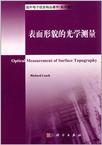表面形貌的光学测量
出版时间:2012-6 出版社:科学出版社 作者:里奇 页数:323 字数:501250
内容概要
本书介绍了表面形貌测量领域中一系列国际标准规范。复杂的准则都是基于新的测量技术而产生的。目前有很多用来测量表面形貌新的光学技术,每种方法都有其优点以及局限性。本书既适用于业界及学术研究领域的工程人员, 也适用于相关领域的研究生及高年级本科生。
书籍目录
1 Introduction to Surface Texture Measurement Richard Leach1.1 Surface Texture Measurement1.2 Surface Profile and Areal Measurement1.3 Areal Surface Texture Measurement1.4 Surface Texture Standards and GPS1.4.1 Profile Standards1.4.2 Areal Specification Standards1.5 Instrument Types in the ISO 25178 Series1.5.1 The Stylus Instrument1.5.2 Scanning Probe Microscopes1.5.3 Scanning Electron Microscopes1.5.4 Optical Instrument Types1.6 Considerations When Choosing a MethodAcknowledgementsReferences2 Some Common Terms and Definitions Richard Leach2.1 Introduction2.2 The Principal Aberrations2.3 Objective Lenses2.4 Magniflcation and Numerical Aperture2.5 Spatial Resolution2.6 Optical Spot Size2.7 Field of View2.8 Depth of Field and Depth of Focus2.9 Interference ObjectivesAcknowledgementsReferences3 Limitations of Optical 3D Sensors Gerd H?usler,Svenja Ettl3.1 Introduction:What Is This Chapter About?3.2 The Canonical Sensor3.3 Optically Rough and Smooth Surfaces3.4 Type Ⅰ Sensors:Triangulation3.5 Type Ⅱ and Type Ⅲ Sensors:Interferometry3.6 Type Ⅳ Sensors:Deflectometry3.7 Only Four Sensor Principles?3.8 Conclusion and Open QuestionsReferences4 Calibration of Optical Surface Topography Measuring Instruments Richard Leach,Claudiu Giusca4.1 Introduction to Calibration and Traceability4.2 Calibration of Surface Topography Measuring Instruments4.3 Can an Optical Instrument Be Calibrated?4.4 Types of Material Measure4.5 Calibration of Instrument Scales4.5.1 Noise4.5.2 Residual Flatness4.5.3 Amplification,Linearity and Squareness of the Scales4.5.4 Resolution4.6 Relationship between the Calibration,Adjustment and Measurement Uncertainty4.7 SummaryAcknowledgementsReferences5 Chromatic Confocal Microscopy Francois Blateyron5.1 Basic Theory5.1.1 Confocal Setting5.1.2 Axial Chromatic Dispersion5.1.3 Spectral Decoding5.1.4 Height Detection5.1.5 Metrological Characteristics5.1.5.1 Spot Size5.2 Instrumentation5.2.1 Lateral Scanning Configurations5.2.1.1 Profile Measurement5.2.1.2 Areal Measurement5.2.2 Optoelectronic Controller5.2.3 Optical Head5.2.4 Light Source5.2.5 Chromatic Objective5.2.6 Spectrometer5.2.7 Optical Fibre Cord5.3 Instrument Use and Good Practice5.3.1 Calibration5.3.1.1 Calibration of Dark Level5.3.1.2 Linearisation of the Response Curve5.3.1.3 Calibration of the Height Amplification Coefficient5.3.1.4 Calibration of the Lateral Ampliflcation Coefficient5.3.1.5 Calibration of the Hysteresis in Bi-directional Measurement5.3.2 Preparation for Measurement5.3.3 Pre-processing5.4 Limitations of the Technique5.4.1 Local Slopes5.4.2 Scanning Speed5.4.3 Light Intensity5.4.4 Non-measured Points5.4.5 Outliers5.4.6 Interference5.4.7 Ghost Foci5.5 Extensions of the Basic Principles5.5.1 Thickness Measurement5.5.2 Line and Field Sensors5.5.3 Absolute Reference5.6 Case StudiesAcknowledgementsReferences6 Point Autofocus Instruments Katsuhiro Miura,Atsuko Nose6.1 Basic Theory6.2 Instrumentation6.3 Instrument Use and Good Practice6.3.1 Comparison with Roughness Material Measures6.3.2 Three-Dimensional Measurement of Grinding Wheel Surface Topography6.4 Limitations of PAI6.4.1 Lateral Resolution6.4.2 Vertical Resolution6.4.3 The Maximum Acceptable Local Surface Slope6.5 Extensions of the Basic Principles6.6 Case Studies6.7 ConclusionReferences7 Focus Variationl Instruments Franz Helmli7.1 Introduction7.2 Basic Theorg7.2.1 How Does It Work?7.2.2 Acquisition of Image Data7.2.3 Measurement of 3D Information7.2.4 Post-processing7.2.5 Handling of Invalid Points7.3 Difference to Other Techniques7.3.1 Difference to Imaging Confocal Microscopy7.3.2 Difference to Point Auto Focusing Techniques7.4 Instrumentation7.4.1 Optical System7.4.2 CCD Sensor7.4.3 Light Source7.4.4 Microscope Obiective7.4.5 Driving Unit7.4.6 Practical Instrument Realisation7.5 Instrument Use and Good Practice7.6 Limitations of the Technology7.6.1 Translucent Materials7.6.2 Measurable Surfaces7.7 Extensions of the Basic Principles7.7.1 Repeatability Information7.7.2 High Radiometric Data Accluisition7.7.3 2D Alignment7.7.4 3D Alignment7.8 Case Studies7.8.1 Surface Texture Measurement of Worn Metal Parts7.8.2 Form Measurement of Complex Tap Parameters7.9 ConclusionAcknowledgementsReferences8 Phase Shifting Interferometry Peter de Groot8.1 Conceot and Overview8.2 Principles of Surface Measurement Interferometry8.3 Phase Shifting Method8.4 Phase Unwrapping8.5 Phase Shifting Error Analysis8.6 Interferometer Design8.7 Lateral Resolution8.8 Focus8.9 Light Sources8.10 Calibration8.11 Examples of PSI MeasurementReferences9 Coherence Scanning Interferometry Peter de Groot9.1 Conceot and Overview9.2 Terminology9.3 Typical Configurations of CSI9.4 Signal Formation9.5 Signal Processing9.6 Foundation Metrics and Height Calibration for CSI9.7 Dissimilar Materials9.8 Vibrational Sensitivity9.9 Transparent Films9.10 Examples9.11 ConclusionReferences10 Digital Holographic Microscopy Tristan Coolmb,Jonas Kühn10.1 Introduction10.2 Basic Theory10.2.1 Acquisition10.2.2 Reconstruction10.3 Instrumentation10.3.1 Light Source10.3.2 Digital Camera10.3.3 Microscope Obiective10.3.4 Optical Path Retarder10.4 Instrument Use and Good Practice10.4.1 Digital Focusing10.4.2 DHM Parameters10.4.3 Automatic Working Distance in Reflection DHM10.4.4 Sample Preoaration and Immersion Liquids10.5 Limitations of DHM10.5.1 Parasitic Interferences and Statistical Noise10.5.2 Height Measurement Range10.5.3 Sample Limitation10.6 Extensions of the Basic DHM Principles10.6.1 Multi-wavelength DHM10.6.1.1 Extended Measurement Range10.6.1.2 Mapping10.6.2 Stroboscopic Measurement10.6.3 DHM Reflectometry10.6.4 Infinite Focus10.6.5 Applications of DHM10.6.5.1 Topography and Defect Detection10.6.5.2 Roughness10.6.5.3 Micro-optics Characterization10.6.5.4 MEMS and MOEMS10.6.5.5 Semi-transparent Micro-structures10.7 ConclusionsReferences11 Imaging Confocal Microscopy Roger Artigas11.1 Basic Theory11.1.1 Introduction to Imaging Confocal Microscopes11.1.2 Working Principle of an Imaging Confocal Microscope11.1.3 Metrological Algorithm11.1.4 Image Formation of a Confocal Microscope11.1.4.1 General Description of a Scanning Microscope11.1.4.2 Point Spread Function for the Limiting Case of an Infinitesimally Small Pinhole11.1.4.3 Pinhole Size Effect11.2 Instrumentation11.2.1 Types of Confocal Microscopes11.2.1.1 Laser Scanning Confocal Microscope Configuration11.2.1.2 Disc Scanning Confocal Microscope Configuration11.2.1.3 Programmable Array Scanning Confocal Microscope Configuration11.2.2 Objectives for Confocal Microscopy11.2.3 Vertical Scanning11.2.3.1 Motorised Stares with Optical Linear Encoders11.2.3.2 Piezoelectric Stages11.2.3.3 Comparison between Motorised and Piezoelectric Scanning Stages11.3 Instument Use and Good Practice11.3.1 LocatiOn of an Imaging Confocal Microscope11.3.2 Setting Up the Sample11.3.3 Setting the Right Scanning Parameters11.3.4 Simultaneous Detection of Confocal and Bright Field Images11.3.5 Sampling11.3.6 Low Magniflcation against Stitching11.4 Limitatioas of Imaging Confocal Microscopy11.4.1 Maximum Detectable Slope on Smooth Surfaces11.4.2 Noise and Resolution in Imaging Confocal Microscopes11.4.3 Errors in Imaring Confocal Microscopes11.4.3.1 Objective Flatness Error11.4.3.2 Calibration of the Flatness Error11.4.3.3 Measurements on Thin Transparent Materials11.4.4 Lateral Resolution11.5 Measurement of Thin and Thick Film with Imaging Confocal Microscopy11.5.1 Introduction11.5.2 Thick Films11.5.3 Thin Films11.6 Case Study:Roughness Prediction on Steel PlatesReferences12 Light Scattering Methods Theodore V.Vorburger,Richard Silver,Rainer Brodmann,Boris Brodmann,J?rg Seewig12.1 Introduction12.2 Basic Theory12.3 Instrumentation and Case Studies12.3.1 Early Developments12.3.2 Recent Developments in Instrumentation for Mechanical Engineering Manufacture12.3.3 Recent Developments in Instrumentation for Semiconductor Manufacture(Optical Critical Dimension)12.4 Instrument Use and Good Practice12.4.1 SEMI MF 1048-1109(2009)Test Method for Measuring the Effective Surface Roughness of Optical Components by Total Integrated Scattering12.4.2 SEMI ME 1392-1109(2009)Guide for Angle-Resolved Optical Scatter Measurements on Specular or Diffuse Surfaces12.4.3 ISO10110-8:2010 Optics and Photonics-Preparation of Drawings for Optical Elements and Systems-Part 8:Surface Texture12.4.4 Standards for Gloss Measurement12.4.5 VDA Guideline 2009,Geometrische Produktspezifikation Oberfl?chenbeschaffenheit Winkelaufgel?ste Streulichtmesstech-nik Definition,Kenngr?βen und Anwendung(Light Scattering Measurement Technique)12.5 Limitations of the Technique12.6 Extensions of the Basic PrinciplesAcknowledgementsReferencesIndex
图书封面
评论、评分、阅读与下载
用户评论 (总计4条)
- 质量挺好的!!!
- 以前从国外复印回来,内容比较新,介绍了06年以前常用光学仪器的原理和一些进展。内容还是比较全面,不用到处查资料。
- 对表面形貌的光学测量内容归纳的较详细,但内容不够前沿。
- 都是国外相关公司的权威人士写得文章,对于了解目前表面形貌先进的原理和设计有帮助。
相关图书
- 红外热成像测温原理与技术
- 发酵工业原料炼制原理与应用
- 光学遥感信号处理与开发技术
- 中高磷铁水的冶炼
- 海洋工程腐蚀损伤数据库与数字仿真技术
- 广义线性系统分析与设计
- 小冲孔微试样材料性能测试技术及应用
- TMS320C2000DSP技术手册
- 装配式桥梁设计
- 绩效导向型公共财政
- 新中国工业化思想简论
- 区域创新与生态效率革命
- 21世纪现代化的特征与前途
- 再生资源产业研究
- 基于全面建设小康社会的可持续发展战略研究
- 大型企业集团创新治理
- 品牌重叠测评模型及应用研究
- 环境法基本理论研究
- 多源信息密度集结算子理论及应用
- 和谐假说
- 我国高校教学科研人员绩效考评研究
- 新课改背景下英语教学理念与实践
- 高职教师工作心理管理实证研究
- 考古地理信息系统
- 中外技术转移模式的比较
